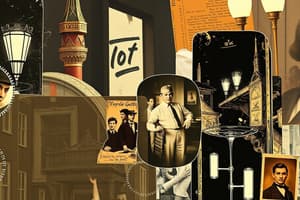Podcast
Questions and Answers
What is the primary feature that distinguishes prose from poetry?
What is the primary feature that distinguishes prose from poetry?
- Prose utilizes figurative language, whereas poetry uses literal language.
- Prose is structured using standard language, while poetry employs meter or verse. (correct)
- Prose is performative, while poetry is meant solely for reading.
- Prose is written in verse form, while poetry is written in paragraph form.
Which of the following best describes the nature of literature?
Which of the following best describes the nature of literature?
- A collection of writings that are informative or scientific in nature.
- An imaginative composition that expresses life with excellence in form. (correct)
- A documentation of historical events using dramatic storytelling.
- Any text that is used in a classroom setting for educational purposes.
What aspect of poetry is emphasized besides meaning?
What aspect of poetry is emphasized besides meaning?
- Literal interpretation of themes.
- The visual representation of text on the page.
- The historical context of the word choices.
- The use of sound through meter and rhythm. (correct)
Which statement about prose is true?
Which statement about prose is true?
In the example provided about Tung-ming, what distinguishes his art from Western painting styles?
In the example provided about Tung-ming, what distinguishes his art from Western painting styles?
What aspect of a story does 'conflict' primarily involve?
What aspect of a story does 'conflict' primarily involve?
What is the purpose of the exposition in a plot?
What is the purpose of the exposition in a plot?
Which part of the plot follows the climax?
Which part of the plot follows the climax?
In which plot structure does the protagonist face numerous obstacles while pursuing an important object?
In which plot structure does the protagonist face numerous obstacles while pursuing an important object?
Which element of fiction primarily refers to the emotional quality conveyed in a narrative?
Which element of fiction primarily refers to the emotional quality conveyed in a narrative?
What does the conclusion (Dénouement) of a plot typically present?
What does the conclusion (Dénouement) of a plot typically present?
What defines a character in a fictional narrative?
What defines a character in a fictional narrative?
Which plot structure is best described as a transformation often prompted by important events in the story?
Which plot structure is best described as a transformation often prompted by important events in the story?
What defines a round character?
What defines a round character?
Which statement best describes a static character?
Which statement best describes a static character?
What is a common characteristic of stock characters?
What is a common characteristic of stock characters?
Which type of point of view allows insights into the thoughts and experiences of characters?
Which type of point of view allows insights into the thoughts and experiences of characters?
What distinguishes a dynamic character from a static character?
What distinguishes a dynamic character from a static character?
How does first-person point of view enhance a story?
How does first-person point of view enhance a story?
Which of the following best describes flat characters?
Which of the following best describes flat characters?
What is a key feature of second-person point of view?
What is a key feature of second-person point of view?
What does the term 'setting' in literature refer to?
What does the term 'setting' in literature refer to?
Which of the following best describes 'local color' in literature?
Which of the following best describes 'local color' in literature?
What is the primary purpose of a literary symbol?
What is the primary purpose of a literary symbol?
How can tone in literature be defined?
How can tone in literature be defined?
What role does a symbol play in literature?
What role does a symbol play in literature?
How do writers typically emphasize symbols in their work?
How do writers typically emphasize symbols in their work?
What does the theme of a literary work represent?
What does the theme of a literary work represent?
In which excerpt can you find an example of local color?
In which excerpt can you find an example of local color?
Which literary device involves a narrative interruption to show a previous event?
Which literary device involves a narrative interruption to show a previous event?
Which tone is reflected in the excerpt describing people taking chances with chemicals?
Which tone is reflected in the excerpt describing people taking chances with chemicals?
What is the function of foreshadowing in literature?
What is the function of foreshadowing in literature?
What is NOT a characteristic of setting in literature?
What is NOT a characteristic of setting in literature?
What does the phrase 'ugly places where there were only ugly things to do' suggest about the characters' tone?
What does the phrase 'ugly places where there were only ugly things to do' suggest about the characters' tone?
Flashcards are hidden until you start studying
Study Notes
Literary Symbols
- Literary symbols serve as extended figures of speech, enriching texts with deeper significance.
- In The Great Gatsby, Gatsby's green light symbolizes unattainable dreams and aspirations.
Emphasis on Symbols
- Writers highlight symbols by providing thorough descriptions.
- Introduction of symbols at unexpected moments can elevate their importance.
- Frequent references to symbols ensure they resonate with readers.
Theme
- Themes represent the overarching ideas or moral messages in literary works.
- Understanding a work's theme is crucial for a complete literary analysis.
Other Literary Devices in Fiction
- Flashback: Interruptions that reveal earlier events, enhancing narrative depth.
- Foreshadowing: Hints of upcoming events build suspense throughout the narrative.
- Irony: The difference between expectations and reality creates a layer of complexity.
- Deus Ex Machina: An abrupt resolution to complex problems, often in an unconvincing manner.
Literature Overview
- Literature is imaginative writing of acknowledged artistic value, expressing life with a high standard of form.
- It can be classified into prose and poetry.
Forms of Literature
- Prose: Communicates in paragraph form using everyday, literal language.
- Poetry: Structured in verse, utilizing imagery and figurative language to convey emotions.
Example of Prose
- The story of Tung-ming, a 14th-century Chinese monk and painter, exemplifies prose through its narrative style and character detail.
Poetry
- Poetry employs meter/verse to express emotions and ideas using various literary techniques, including imagery and repetition.
Fiction
- Fiction encompasses narratives of imaginary or invented events, distinct from factual accounts.
Elements of Fiction
- Elements include plot, characters, point of view, setting, tone, symbol, and theme.
Plot Structure
- The plot arranges events and drives the story through conflict, either internal or external.
- Parts of the plot:
- Exposition: Introduces characters and setting.
- Rising Action: Builds tension with complications.
- Climax: Culminates in emotional intensity and decision points.
- Falling Action: Resolves tensions and leads to conclusions.
- Conclusion (Dénouement): Provides closure and a new stable situation.
Common Plot Structures
- Overcoming the Monster: Protagonist battles a threatening force.
- Rags to Riches: Character rises to wealth and status, often experiencing loss before triumph.
- The Quest: A journey for an important object or goal, involving challenges and growth.
- Rebirth: Character undergoes transformation due to significant events or realizations.
Characters in Fiction
- Characters may be human or non-human and must possess relatable human qualities.
- Types of Characters:
- Round: Complex with conflicting motivations.
- Dynamic: Evolve throughout the story.
- Flat: Simple, unchanging characters.
- Static: Do not undergo significant change.
- Stock: Stereotypical characters drawn from common literary tropes.
Point of View
- The perspective from which a story is told influences reader engagement and understanding.
- First-Person: Narrator is a character within the story.
- Second-Person: Narrator directly addresses the reader.
- Third-Person: Narrator is outside the story, can be limited or omniscient.
Setting
- Consists of the time, place, and social context of a story. Often described generically to allow universal applicability.
Local Color
- Detailed portrayal of a specific place or period, enhancing the narrative's authenticity.
Tone
- Reflects the author's attitude toward the subject and audience, characterized by specific word choices and emotional undertones.
- Examples depict various tones ranging from solemn to humorous.
Symbol
- Represents concepts or ideas beyond literal meaning through objects, pictures, or sounds, creating associations in literature.
Studying That Suits You
Use AI to generate personalized quizzes and flashcards to suit your learning preferences.




